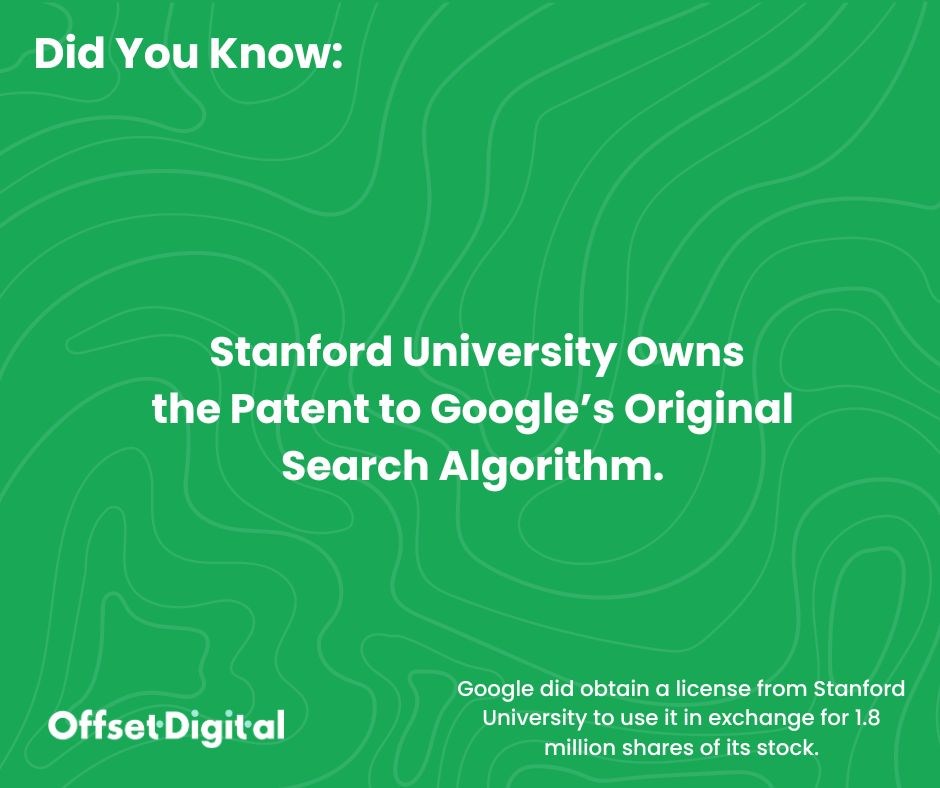Does Stanford University Really own the Patent to Google’s Original Search Algorithm?
Stanford University stands as an institution renowned for its contributions to innovation. One of its most notable connections is its involvement in the birth of Google’s original search algorithm. This article delves into the intriguing story of how Stanford University owns the patent to Google’s groundbreaking algorithm.
Where Academia Meets the Industry.
The Birth of Google's Original Search Algorithm
Google, the search engine giant that has revolutionized the way we access information, began its journey as a research project by Larry Page and Sergey Brin while they were pursuing their Ph.D. studies at Stanford in the late 1990s. Their goal was to create a more efficient and effective way to navigate the burgeoning World Wide Web.
This partnership granted the university a stake in the search engine’s future, setting the stage for the intriguing patent ownership.
Larry Page and Sergey Brin's Vision
Page and Brin envisioned a search engine that could not only find web pages but also rank them by their relevance and importance. This vision laid the foundation for what we now know as Google’s search algorithm.
The Stanford Connection
Stanford University played a pivotal role in nurturing the innovative minds of Page and Brin. Their studies and research at the university were instrumental in shaping the core concepts of their search algorithm.
The PageRank Algorithm
Central to Google’s success is the PageRank algorithm, which assigns a numerical weight to each element within a hyperlinked set of documents, effectively determining the importance of web pages. This algorithm was developed during their time at Stanford.
The Google Partnership with Stanford
In the early stages of Google’s development, Page and Brin established a formal partnership with Stanford University. This partnership granted the university a stake in the search engine’s future, setting the stage for the intriguing patent ownership.
The Patenting Process
As Google grew in prominence, the issue of patenting the technology arose. The patent application, filed in 1998, listed Stanford University as the assignee, effectively giving Stanford rights to the original search algorithm.
Controversies and Challenges
The patent ownership raised eyebrows and led to discussions within the tech community. Critics argued that Page and Brin’s research was conducted on university premises, using university resources, and hence the patent belonged to Stanford.
Stanford’s Stance on the Patent
Stanford, on the other hand, maintained that they did not pursue ownership but rather allowed Page and Brin to own the patent while retaining certain rights to the technology. The university’s stance was seen as a generous gesture toward its former students.
FAQs
What is PageRank, and how does it work? PageRank is a link analysis algorithm used by Google to rank web pages in search results. It works by assigning numerical weights to pages based on their importance and relevance.
Did Stanford University profit from the patent ownership? While Stanford retained certain rights to the technology, it didn’t actively profit from the patent ownership. Google’s founders primarily benefitted from their creation.
What was the initial purpose of Google’s search algorithm? The original purpose of Google’s algorithm was to create a more efficient and effective way to navigate the World Wide Web, finding and ranking web pages by relevance and importance.
How has Google’s search algorithm evolved over the years? Google’s search algorithm has undergone numerous updates and changes to adapt to the changing web landscape and user demands.
What is the significance of the Google-Stanford partnership for the tech industry? The partnership showcases the collaborative nature of academia and industry, highlighting how innovation can flourish in such an environment.
Implications of the Patent
The patent ownership had far-reaching implications. It bolstered Stanford’s reputation as an institution that nurtured groundbreaking innovations, while also causing some ripples in the tech industry.
The Evolution of Google’s Algorithm
Over the years, Google’s search algorithm has evolved significantly, with multiple updates and changes. While the original algorithm formed the core, continuous innovation has been key to maintaining Google’s position as the leading search engine.
Google’s Commitment to Innovation
Google’s journey from a Stanford research project to a global technology giant underscores the company’s commitment to innovation, constantly pushing the boundaries of what’s possible in the digital landscape.
The Impact on the Tech Industry
The story of Stanford University’s ownership of the patent to Google’s original search algorithm is not just a tale of legalities; it’s a testament to the symbiotic relationship between academia and industry, and its impact on the tech world.


